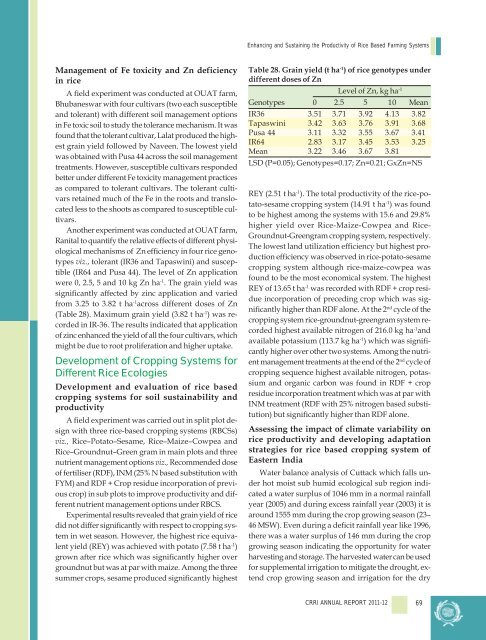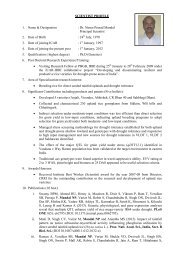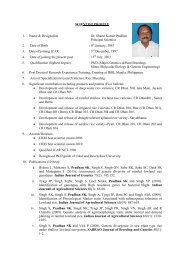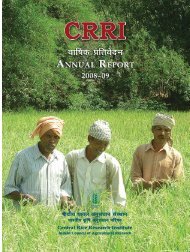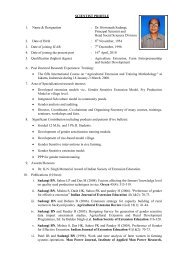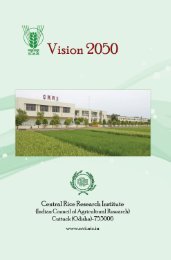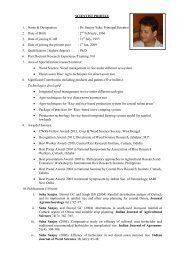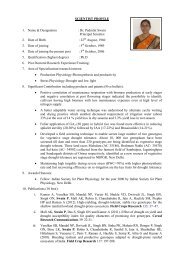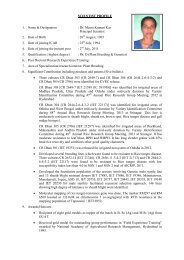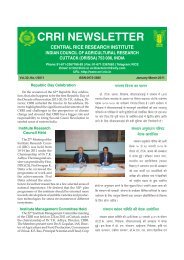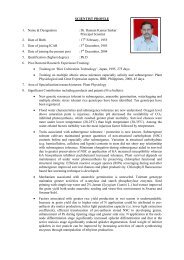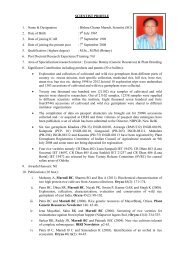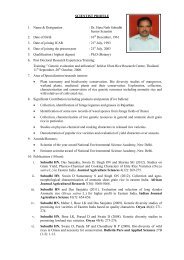Central Rice Research Institute Annual report...2011-12
Central Rice Research Institute Annual report...2011-12
Central Rice Research Institute Annual report...2011-12
You also want an ePaper? Increase the reach of your titles
YUMPU automatically turns print PDFs into web optimized ePapers that Google loves.
Enhancing and Sustaining the Productivity of <strong>Rice</strong> Based Farming Systems<br />
Management of Fe toxicity and Zn deficiency<br />
in rice<br />
A field experiment was conducted at OUAT farm,<br />
Bhubaneswar with four cultivars (two each susceptible<br />
and tolerant) with different soil management options<br />
in Fe toxic soil to study the tolerance mechanism. It was<br />
found that the tolerant cultivar, Lalat produced the highest<br />
grain yield followed by Naveen. The lowest yield<br />
was obtained with Pusa 44 across the soil management<br />
treatments. However, susceptible cultivars responded<br />
better under different Fe toxicity management practices<br />
as compared to tolerant cultivars. The tolerant cultivars<br />
retained much of the Fe in the roots and translocated<br />
less to the shoots as compared to susceptible cultivars.<br />
Another experiment was conducted at OUAT farm,<br />
Ranital to quantify the relative effects of different physiological<br />
mechanisms of Zn efficiency in four rice genotypes<br />
viz., tolerant (IR36 and Tapaswini) and susceptible<br />
(IR64 and Pusa 44). The level of Zn application<br />
were 0, 2.5, 5 and 10 kg Zn ha -1 . The grain yield was<br />
significantly affected by zinc application and varied<br />
from 3.25 to 3.82 t ha -1 across different doses of Zn<br />
(Table 28). Maximum grain yield (3.82 t ha -1 ) was recorded<br />
in IR-36. The results indicated that application<br />
of zinc enhanced the yield of all the four cultivars, which<br />
might be due to root proliferation and higher uptake.<br />
Development of Cropping Systems for<br />
Different <strong>Rice</strong> Ecologies<br />
Development and evaluation of rice based<br />
cropping systems for soil sustainability and<br />
productivity<br />
A field experiment was carried out in split plot design<br />
with three rice-based cropping systems (RBCSs)<br />
viz., <strong>Rice</strong>–Potato–Sesame, <strong>Rice</strong>–Maize–Cowpea and<br />
<strong>Rice</strong>–Groundnut–Green gram in main plots and three<br />
nutrient management options viz., Recommended dose<br />
of fertiliser (RDF), INM (25% N based substitution with<br />
FYM) and RDF + Crop residue incorporation of previous<br />
crop) in sub plots to improve productivity and different<br />
nutrient management options under RBCS.<br />
Experimental results revealed that grain yield of rice<br />
did not differ significantly with respect to cropping system<br />
in wet season. However, the highest rice equivalent<br />
yield (REY) was achieved with potato (7.58 t ha -1 )<br />
grown after rice which was significantly higher over<br />
groundnut but was at par with maize. Among the three<br />
summer crops, sesame produced significantly highest<br />
Table 28. Grain yield (t ha -1 ) of rice genotypes under<br />
different doses of Zn<br />
Level of Zn, kg ha -1<br />
Genotypes 0 2.5 5 10 Mean<br />
IR36 3.51 3.71 3.92 4.13 3.82<br />
Tapaswini 3.42 3.63 3.76 3.91 3.68<br />
Pusa 44 3.11 3.32 3.55 3.67 3.41<br />
IR64 2.83 3.17 3.45 3.53 3.25<br />
Mean 3.22 3.46 3.67 3.81<br />
LSD (P=0.05); Genotypes=0.17; Zn=0.21; GxZn=NS<br />
REY (2.51 t ha -1 ). The total productivity of the rice-potato-sesame<br />
cropping system (14.91 t ha -1 ) was found<br />
to be highest among the systems with 15.6 and 29.8%<br />
higher yield over <strong>Rice</strong>-Maize-Cowpea and <strong>Rice</strong>-<br />
Groundnut-Greengram cropping system, respectively.<br />
The lowest land utilization efficiency but highest production<br />
efficiency was observed in rice-potato-sesame<br />
cropping system although rice-maize-cowpea was<br />
found to be the most economical system. The highest<br />
REY of 13.65 t ha -1 was recorded with RDF + crop residue<br />
incorporation of preceding crop which was significantly<br />
higher than RDF alone. At the 2 nd cycle of the<br />
cropping system rice-groundnut-greengram system recorded<br />
highest available nitrogen of 216.0 kg ha -1 and<br />
available potassium (113.7 kg ha -1 ) which was significantly<br />
higher over other two systems. Among the nutrient<br />
management treatments at the end of the 2 nd cycle of<br />
cropping sequence highest available nitrogen, potassium<br />
and organic carbon was found in RDF + crop<br />
residue incorporation treatment which was at par with<br />
INM treatment (RDF with 25% nitrogen based substitution)<br />
but significantly higher than RDF alone.<br />
Assessing the impact of climate variability on<br />
rice productivity and developing adaptation<br />
strategies for rice based cropping system of<br />
Eastern India<br />
Water balance analysis of Cuttack which falls under<br />
hot moist sub humid ecological sub region indicated<br />
a water surplus of 1046 mm in a normal rainfall<br />
year (2005) and during excess rainfall year (2003) it is<br />
around 1555 mm during the crop growing season (23–<br />
46 MSW). Even during a deficit rainfall year like 1996,<br />
there was a water surplus of 146 mm during the crop<br />
growing season indicating the opportunity for water<br />
harvesting and storage. The harvested water can be used<br />
for supplemental irrigation to mitigate the drought, extend<br />
crop growing season and irrigation for the dry<br />
CRRI ANNUAL REPORT 2011-<strong>12</strong><br />
69


